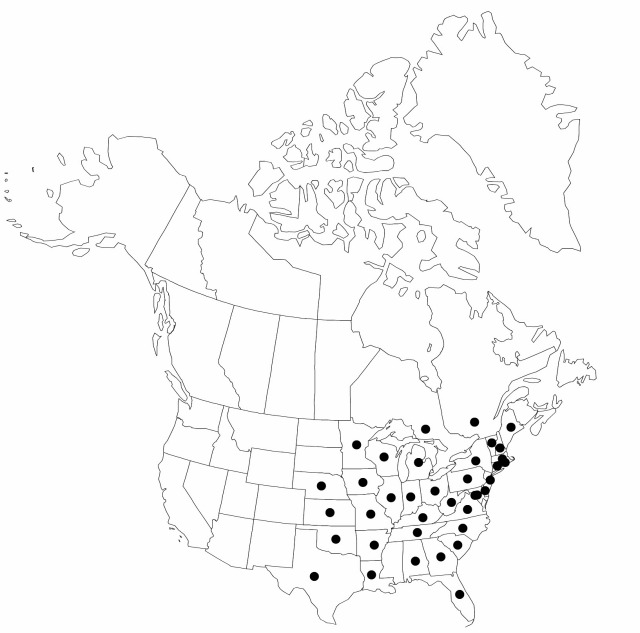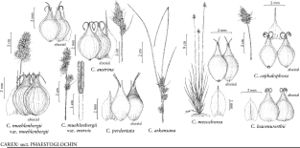Difference between revisions of "Carex cephalophora"
Sp. Pl. 4(1): 220. 1805.
FNA>Volume Importer |
FNA>Volume Importer |
||
| Line 24: | Line 24: | ||
|elevation=50–500 m | |elevation=50–500 m | ||
|distribution=Ont.;Que.;Ala.;Ark.;Conn.;Del.;D.C.;Fla.;Ga.;Ill.;Ind.;Iowa;Kans.;Ky.;La.;Maine;Mass.;Md.;Mich.;Minn.;Mo.;Nebr.;N.H.;N.J.;N.Y.;N.C.;Ohio;Okla.;Pa.;R.I.;S.C.;Tenn.;Tex.;Vt.;Va.;W.Va.;Wis. | |distribution=Ont.;Que.;Ala.;Ark.;Conn.;Del.;D.C.;Fla.;Ga.;Ill.;Ind.;Iowa;Kans.;Ky.;La.;Maine;Mass.;Md.;Mich.;Minn.;Mo.;Nebr.;N.H.;N.J.;N.Y.;N.C.;Ohio;Okla.;Pa.;R.I.;S.C.;Tenn.;Tex.;Vt.;Va.;W.Va.;Wis. | ||
| − | |discussion=<p>The record of Carex cephalophora from California is referable to C. mesochorea.</p> | + | |discussion=<p>The record of <i>Carex cephalophora</i> from California is referable to <i>C. mesochorea</i>.</p> |
|tables= | |tables= | ||
|references= | |references= | ||
| Line 48: | Line 48: | ||
|publication year=1805 | |publication year=1805 | ||
|special status= | |special status= | ||
| − | |source xml=https://jpend@bitbucket.org/aafc-mbb/fna-data-curation.git/src/ | + | |source xml=https://jpend@bitbucket.org/aafc-mbb/fna-data-curation.git/src/8f726806613d60c220dc4493de13607dd3150896/coarse_grained_fna_xml/V23/V23_510.xml |
|genus=Carex | |genus=Carex | ||
|section=Carex sect. Phaestoglochin | |section=Carex sect. Phaestoglochin | ||
Revision as of 16:08, 18 September 2019
Plants without conspicuous rhizomes. Culms 20–60 cm, 2–3.5 mm wide basally, 0.5–1 mm wide distally. Leaves: sheaths tight, green, rarely white spotted, fronts hyaline, slightly thickened at mouth; ligules to 5 mm, longer than wide; widest leaf blades (1.9–)2.5–5 mm wide. Inflorescences forming dense heads, with 3–8 spikes, 0.6–2 cm × 5–10 mm; proximal bracts 1–5 cm; spikes with 4–20 ascending to spreading perigynia. Pistillate scales hyaline with green midvein, ovate, 1–1.8 × 0.8–1.4 mm, body not more than 1/2 length of perigynium, apex acuminate to short-awned. Anthers 0.7–1.3 mm. Perigynia pale green to pale yellow, veinless or to weakly 8-veined abaxially, 2.5–3.2 × 1.4–2 mm, body elliptic to circular, widest at 0.4–0.55 length of body, margins serrulate distally; beak 0.7–1.1 mm, apical teeth 0.3–0.5 mm. Achenes circular, 1 × 1 mm. 2n = 48.
Phenology: Fruiting late spring–early summer.
Habitat: Dry to wet-mesic deciduous or mixed forests, thickets, rarely open grassy habitats
Elevation: 50–500 m
Distribution

Ont., Que., Ala., Ark., Conn., Del., D.C., Fla., Ga., Ill., Ind., Iowa, Kans., Ky., La., Maine, Mass., Md., Mich., Minn., Mo., Nebr., N.H., N.J., N.Y., N.C., Ohio, Okla., Pa., R.I., S.C., Tenn., Tex., Vt., Va., W.Va., Wis.
Discussion
The record of Carex cephalophora from California is referable to C. mesochorea.
Selected References
None.
